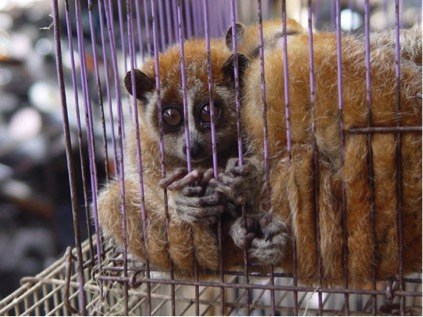|
By Alexandra DeCandia
On February 17th, “little monsters” were in uproar: a poisonous primate had the audacity to bite Lady Gaga. A fuzzy prop in her latest music video, the offending slow loris nipped the star’s finger and was immediately returned to its box and carried away “in disgrace,” its role stricken from the video. The media loved this story. Due to the victim’s high profile and the aggressor’s status as the “cutest animal in the world,” the incident appeared in print, on television, and all over the Internet. With the exception of conservation blogs, the majority of coverage laughed it off as entertainment, joke-fodder, and a segue into listing tour dates. Within days, it was old news, and nothing more than yesterday’s anecdote. However, the story deserves more than cursory attention. The “disgraced” slow loris, reduced to nothing more than a badly behaved prop, is just one of thousands culled from the wild and forced into the exotic pet trade. A multi-billion dollar industry, this illegal trade of endangered species is fueled by YouTube videos (e.g. “tickling slow loris”) and uninformed celebrity endorsements (e.g. Gaga’s attempt to feature a loris in her music video) that are tickling species into extinction (Nekaris et al., 2013). All five species of slow loris (Javan, Bengal, Bornean, Sunda, and Pygmy) are considered Vulnerable or Endangered by the International Union for Conservation of Nature (IUCN). Nocturnal primates endemic to rainforests in South and Southeast Asia, they are primarily threatened by deforestation (i.e. habitat loss and fragmentation) and harvesting. While governments throughout their home range protect slow lorises from the latter, enforcement remains elusive. What’s more, despite their listing in Appendix I (which permits no trade) of the Convention on the International Trade of Endangered Species (CITES), slow lorises remain among the most commonly traded primates. They are sought for bush meat, traditional medicines, and exotic pets, and the demand is only strengthening. Unfortunately, slow loris biology and behavior render them particularly vulnerable to poaching. Their large eyes, crucial for hunting insects at night, brightly reflect flashlight beams. Their defense mechanisms, silent stillness and saliva-activated poison, afford little protection from harvesters. Their parenting style, “infant parking,” leaves poison-covered young hidden from predators but defenseless from humans. In these ways, slow lorises are sitting ducks, and in a market demanding their parts and tickles, they’re an attractive paycheck for poachers. There’s more cruelty to this story than mere capture, however. Medicine-bound slow lorises endure any number of horrors between forest and cabinet. Some creatures have their carcasses soaked in rice wine to create a tonic for easing pain during childbirth. Others are burned alive until their eyes burst, releasing minyak kukang, oil believed to restore vigor and incite love. Others still are dried on sticks and sold whole-bodied in the marketplace to be manipulated by the consumer. These practices are horrifying, yet they often occur right before the eyes of ambivalent law enforcement officials. In comparison to these medicinal practices, the pet trade may appear a more humane endeavor. However, the attrition rate of slow lorises in captivity reveals a different story. These animals are incredibly stress-sensitive. If they aren’t killed upfront by poachers separating mother from young, they often die in metal cages during transport from disease, malnutrition, or simply stress. In yet another display of cruelty, poachers even extract the slow loris’ teeth with pliers or nail clippers (and no anesthetic) to make them appear cuddlier to pet owners. This practice, pain notwithstanding, often causes young lorises to contract infections or even bleed to death. As a result of these practices, an estimated 30-90% of slow lorises captured for the pet trade die before ever reaching market. These numbers are astronomical and, unfortunately, not uncommon in the illegal trade of exotic wildlife. It is highly unlikely that the slow loris (almost) featured in Lady Gaga’s music video was bred in captivity. Like the thousands of other slow lorises in the pet trade, it was almost assuredly culled from the wild. Thus, rather than the animal being “disgraced” by the incident, I argue that the humans involved should be blamed. The poacher who tore the loris from its natural habitat, the middlemen who caged and smuggled it into the United States, the animal trainer who brought the animal to the shoot, and Lady Gaga, who sought to utilize the endangered creature as a prop, all took part in this multi-billion dollar industry built on the carcasses of exotic wildlife. Disgrace, in this instance, is theirs. Don’t join this queue of pain and suffering. If you see a video on YouTube featuring these creatures as pets, flag it. If you hear of a celebrity posing with an animal in Asia (as Rihanna did in 2009) or filming it in America (as Lady Gaga just did), condemn it. Finally, above all else, do not seek exotic wildlife as household pets. There are dozens of common, domesticated species that rely on humans for survival. Exotic animals are not among them. Leave slow lorises where they belong: in rainforests, not cages.
0 Comments
Leave a Reply. |
Categories
All
Archives
April 2024
|

